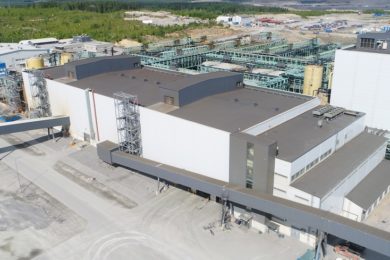The former Talvivaara nickel mine in central Finland is back in the black and looking to new developments four years after the previous owner went bankrupt.
Operating under Terrafame, majority owned by the Finnish government through the Finnish Minerals Group, the mine is finally making good on its early promise.
On a site visit to the mine this week, part of the Finland Mine Safari programme for analysts and investors, CEO Joni Lukkaroinen talked about getting back to planned capacity of 35,000 t/y of nickel, 75,000 t/y of zinc, 1,400 t/y of cobalt and 5,000 t/y of copper.
The company hasn’t set out to change any major part of the process flowsheet to do this – it is still using a two-stage bioheapleaching process to produce a nickel-rich pregnant leach solution that is precipitated as sulphides in the plant – but it has refined the operations Talvivaara started up almost a decade ago.
On top of this, the company is looking to bolt on a hydrogen sulphide line that could see the company produce 170,000 t/y of nickel sulphate and 7,400 t/y of cobalt sulphate for the emerging electric vehicle battery market, in addition to 115,000 t/y of ammonium sulphate for fertilisers.
And, it also has a near-completed uranium plant that could potentially produce yellowcake in the medium term should it receive an environmental permit from the relevant authorities.
Talvivaara may be best known for the gypsum pond leak that occurred in late 2012 and saw nickel, uranium and other toxic metals go into the nearby environment, but even before this event led Talvivaara Sotkamo to eventual bankruptcy, it was struggling to achieve the production numbers it had previously forecast as the bioleaching process that justified mining the low-grade ore got the better of it.
Terrafame, which was formed in 2015 specifically to turn the operation around, has already surpassed the former owners’ production record and, earlier this year, started generating postive earnings.
EBITDA excluding work in progress (ore within the leaching pads) came in at a slim €1.6 million ($1.85 million) in the March quarter and more than doubled to €3.3 million in the most recent June quarter.
This is some change from the -€33.3 million and -€24.2 million the company posted in the same periods a year earlier.
Improved year-on-year metal prices have helped this recovery, but the company has also gone from producing 9,791 t and 4,787 t of zinc and nickel concentrate, respectively, in the March quarter of 2017, to a record 15,008 t of zinc and 6,421 t of nickel in the same quarter of 2018.
While these numbers are still some way off full capacity, they are significantly more than the circa-14,000 t per quarter Talvivaara produced at its peak.
There was at least one obvious change to the process Talvivaara set up when IM visited – Terrafame is now using Wirtgen surface miners to improve the material feed that is stacked and reclaimed from the leach pads and moved onto the metals plant – but the improvement in performance has been achieved through several tweaks, according to Lukkaroinen.
He told IM that the company has, among other things, put much more emphasis on improving the agglomeration of the ore, ensured the material on the leachpad is effectively aerated during both leaching stages and monitored the temperature of the exothermic process much more closely. The latter, in particular, is very important in judging success of the leaching.
This is really now starting to pay dividends during the 50 months, combined, the ore sits on the primary and secondary leach pads.
It has also given the company confidence to invest in a hydrogen sulphide plant that could see the company increase its exposure to the EV battery market.
As it stands, the company already sells around 50% of its nickel concentrate to this market, but the production of nickel and cobalt sulphates is likely to see the company retain more value for its product and provide further sales opportunities.
The fully-financed sulphide plant build will take some two years to construct, with start up, subject to regulatory approvals, planned for the second half of 2020. The company is just months away from awarding the major contracts for the construction.
The process, already proven on a commercial scale, will see nickel-cobalt sulphide from the existing production plant processed in an autoclave, before nickel cobalt and impurities are extracted. It will finally move on to a crystallisation phase where two separate sulphate products are produced.
The 170,000 t/y nickel capacity would make the company one of the biggest sulphate producers in the world.










